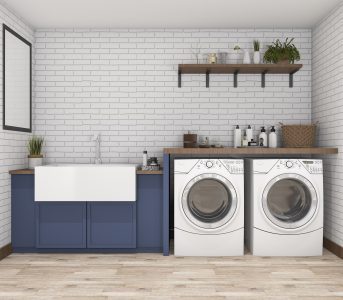Written by Dr. Karen Pendleton
LIVING ROOM
Candles
Scented candles and/or candle warmers are a source of indoor air pollution, which is ironic considering many people use them as air fresheners. Burning paraffin wax releases highly toxic benzene and toluene into the air. These are the same chemicals found in diesel fuel emissions and are known to cause allergies, asthma attacks and skin problems. Candles made of soy wax, beeswax and coconut wax are safer options. Companies like to create blends with paraffin wax to save money, so read labels carefully.
Sofa
If your upholstered furniture was manufactured before 2013, the cushions were treated with flame retardants to satisfy a California law known as Technical Bulletin 117. The California market is huge, so manufacturers adopted the flammability standards specified in this law across the nation to avoid making two different sets of furniture. While the use of flame retardants may sound like a good idea, the chemicals involved have been linked to cancer, reduced IQ, and hyperactivity.
So how do you know if your furniture contains flame retardants? Check for a TB117 tag. Newer furniture will now have a tag that instead says the furniture complies with an updated standard, TB117-2013, and include a check box that specifies whether or not it contains flame retardants.
KITCHEN
Canned Foods
The linings of canned goods may include Bisphenol A (BPA), an ingredient long known to be an endocrine disruptor. This means it can imitate the body’s hormones and interfere with the production, function, and elimination of natural hormones. A 2007 research review published in Reproductive Toxicology found that BPA in the blood of women is linked to obesity, miscarriages, and polycystic ovarian syndrome (PCOS), among other issues.
Many manufacturers now claim their can liners are “BPA-free,” but the substituting chemicals may be just as dangerous as BPA. One example is BPS, which is also an endocrine disruptor and can affect heart function. Buy fresh produce when possible, or choose products in glass or stainless-steel containers.
Non-Stick Cookware
There’s some controversy about whether modern nonstick cookware is safe. While the chemical in the coating that once caused alarm has not been used since 2013 (Perfluorooctanoic acid or PFOA), there is wide disagreement about whether the replacement chemical is any safer.
At temperatures above 570°F, Teflon coatings can start to break down and release toxic chemicals into the air. The result? A condition known as “Teflon flu,” which can cause chills, fever, headache and body aches. To reduce your risk when using nonstick cookware, use low-to-medium heat, be mindful of ventilation, and discard any pans with scratches or peeling. A better option is to use an alternative cookware — ceramic or cast iron are two popular choices. While there’s a learning curve with cast iron, a properly treated pan is so durable that some families pass them down over generations.
My personal cookware of choice for its many valuable benefits, i.e., faster cooking, enjoyable food flavors and better nutrition, is Saladmaster. This cookware is constructed of 316 Surgical Stainless Steel lined with Titanium.
Plastic Containers and Wrap
Phthalates are chemical compounds that are most commonly known for making plastics flexible and cosmetics smear. Often called “plasticizers,” they’re actually found in hundreds of products ranging from perfume to laundry detergent (more about that later). Phthalates are endocrine disruptors, and have been shown in studies to damage the liver, kidneys, lungs and reproductive system. Even Phthalate-free plastic may contain similar harmful chemicals. Here are three easy ways to reduce the use of plastic in your kitchen:
Choose glass food storage containers. You can purchase a set with multiple sizes for $50 or less.
Reusable beeswax wraps are a healthier choice than plastic wrap.
Substitute silicone bags for your favorite brand of resealable storage bags.
The planet will thank you for those changes, too.
BATHROOM
Cleaning Products
If you’re shopping for cleaning products, it’s easy to become overwhelmed with the hundreds of options on the shelves. Which ones are safe?
Here are three easy guidelines to narrow your choices:
Avoid fragrance. The toxic effects of the chemicals used to create that “ocean surf” scent will last far longer than the pleasant smell.
Say no to bleach. Ammonia and chlorine bleach are irritating and corrosive.
Read labels. Look for items in the list of ingredients that you recognize and can pronounce. No ingredient list? Pass.
You can use the Think Dirty app on your phone to check the safety of products before buying them. Scan the UPC label and the app will rate the toxicity of the product on a scale from 0-10. Also check ewg.org for a rating on your favorite cleaning products. It’s common to find many with “D” or “F” ratings in your bathroom cabinets — toss those today!
Beauty Products
Many people assume that beauty products have been tested for safety prior to being placed in stores, but that isn’t true. While products are tested for short-term problems like skin irritation, they’re not tested for long-term safety.
You may find that hard to believe, so here’s an exact quote from fda.gov: “The law does not require cosmetic products and ingredients, except for color additives, to be approved by the FDA before they go on the market.”
Want to be a conscious consumer and do your own research? Don’t expect labels to be very helpful. Loopholes in the law allow the use of generic ingredient names like “fragrance” or “parfum,” which is a catchall phrase that could actually mean any of 10,000 different ingredients. And products sold strictly online are not required to provide ingredient lists at all!
While it may be tempting to fill your bathroom shelves with the lotions and potions recommended by your favorite beauty bloggers, paring down is a healthier option. For example, while I love perfume, I haven’t worn it in years. Certified Pure Therapeutic Grade essential oils are my go-to. And, luckily,
we now have many beauty brands that pride themselves on their clean ingredients, such as two of my faves, Modere and Beautycounter.
Kid’s Bath Toys
The squishy, squeaky bath toys we grew up with contain toxic chemicals, and unfortunately they’re still available in stores today. The main chemicals you want to avoid are Polyvinyl chloride (PVC), Phthalates, and Bisphenols (BPA, BPS).
Discard toys with recycling codes of 3 (PVC) or 7 (BPA, BPS). When buying new toys, check the packaging for statements like “Phthalate-free” or “No BPA.” While I don’t have young children, these brands have been recommended to me: Green Toys, Oli and Carol, and Hevea.
Shower Curtain
If you’ve read this far, you already know you need to replace your shower curtain’s plastic liner. (Yes, it probably contains phthalates.) You can buy a cloth fabric liner for less than $10.
LAUNDRY ROOM
Laundry Detergent


Research the safety of your favorite brand using websites like ewg.org and the results may shock you. Unfortunately, most of the well-known brands in your grocery store are rated “D” or “F.” And don’t assume that a brand with a less-toxic reputation will enjoy a high rating: Method, Mrs. Meyer’s and even Seventh Generation have options in the laundry aisle that are unhealthy choices according to the ratings. Again, Modere home products are what I use.
Dryer Sheets/Fabric Softener
Dryer sheets and fabric softener help with static cling but can pose a health risk, especially if you have sensitive skin, respiratory issues or suffer from migraines.
According to ewg.org, “The mystery mixtures that provide the jolt of fragrance in fabric softeners and dryer sheets can contain hundreds of untested chemicals, including toxic ingredients like phthalates and synthetic musks — both suspected hormone disruptors.” Here are some inexpensive, safer alternatives suggested by healthline.com:
Reusable wool dryer balls. Enjoy scented laundry? Add 2-3 drops of essential oils directly onto each dryer ball; let dry.
White vinegar. Spray vinegar on a washcloth and add it to the dryer, or add ¼ cup of vinegar to your washer’s rinse cycle.
Baking soda. Add a little baking soda to your laundry during the wash cycle.
Reusable static eliminating sheets. Try the Attitude brand (attitudeliving.com and also available on Amazon).
BEDROOM
Mattress
The typical mattress available in your local store is loaded with hazardous chemicals, including:
Various petrochemicals. (Most of what makes up a conventional mattress is petroleum-based.)
Plastics or vinyl.
Flame retardant chemicals.
Synthetic latex, which is usually made from styrene (a human carcinogen).
These chemicals release volatile organic compounds (VOCs) which have been linked to health problems from respiratory irritation to cancer. This is called “off-gassing.” Considering that even busy adults spend 25 percent of their time in bed, having a clean sleep environment is one of the most important goals for anyone looking to reduce their exposure to hazardous chemicals.
Maia James, a consultant who helps clients create safe living environments for their families, often recommends a mattress as the first item to be upgraded when detoxing a home. Her website, gimmethegoodstuff.org, features a safe mattress guide that will save you hours of research and prevent expensive buying mistakes.
Dry Cleaning
If you avoid buying clothes tagged “dry clean only” because of the cleaning hassle, you’re not alone. Unfortunately, most of us own winter jackets, suits, or a few pieces of delicate clothing that require it.
Traditional dry cleaning isn’t dry at all; the clothes are actually soaked in a solvent known as Perchloroethylene (PERC). It’s been declared a “probable human carcinogen” by the International Agency for Research on Cancer (IARC) due to its toxic effects on human health. Symptoms associated with exposure include liver and kidney damage, impaired memory, dizziness, headache and more.
Any residue that remains in clothes can get trapped in the fabric, especially if the garments are covered in plastic bags. How many of those bags are stored in your bedroom closet right now?
Search online for “green dry cleaning” or “professional wet cleaners” in your area to avoid the risks of wearing clothing that has been cleaned using PERC. You don’t have to risk your health to have stain-free clothing.
And that concludes our home tour! Remember: Take one room at a time and don’t try to make too many changes at once. Keep going and soon your home will be a safer, healthier place!
Disclaimer: The information presented here is for educational purposes only. It is not intended or implied to be a substitute for the diagnosis, treatment or advice of a qualified, licensed medical professional. You are encouraged to confirm any information obtained from or through this article with other sources and review all information regarding any medical condition or treatment with your physician.








